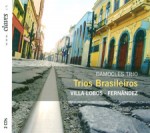Column Name
Title
Mendelssohn Piano Trios. Itzhak Perlman, violin; Yo-Yo Ma, cello; Emanuel Ax, piano. (Sony Classics 88697521922)
Body
It is mildly astonishing that this is the first time that Emanuel Ax, Yo-Yo Ma, and Itzhak Perlman—all Juilliard alums, and in the case of Ax and Perlman, faculty members as well—have collaborated on a recording, given their extensive catalogs to date, but there you go. And even though they have chosen works represented by a very crowded field, these artists have created a treasure that makes one wonder why they waited so long. Engineer Richard King helps immensely, providing cozy warmth from the American Academy of Arts and Letters in New York City to burnish the sound of the ensemble.
Mendelssohn was 30 when he completed his Piano Trio No. 1 in D Minor (1839). His compelling maturity is matched here by the seasoned ardor of these artists. Can there be anyone who has played the Andante con moto tranquillo with such heavenly sweetness, or the third movement Scherzo with such fizz and delicacy? The trio races through the final movement with fiery precision, Perlman adding some graceful pizzicato, and always maintaining equilibrium.
In the Trio No. 2 in C Minor (1845) they set the tone immediately, masterfully shaping the opening theme of the ruminative first movement. Here Mendelssohn’s joyful refrains take on an undercurrent of mystery. Expert attention is given to details and dynamic levels, and there is a hair-raising dash to the finish line. Ma, especially, handles the aching strains of the Andante expressivo with the kind of care lavished by a museum curator uncrating a Picasso. And the skittering lines of the Scherzo are played with elegance to spare. Some may think this movement is taken too fast, but then, if speed can be wedded with articulation like this, why complain? The final movement, with its lush harmonies, only caps a recording that will surely please Mendelssohn lovers to no end—not to mention admirers of these three performers. When Ax’s final chorale beams down, like the sun breaking through after a cloudy morning, all feels right with the world.
Trios Brasileiros. Chamber Music of Villa-Lobos and Fernândez. Damocles Trio. (Claves 50-2916/17)
Heitor Villa-Lobos (1887-1959) was just 24 when he wrote his First Trio for Piano and Strings (1911), a charming work steeped more in European Romanticism—perhaps evoking more of Brahms and Tchaikovsky than the traditions of his native Brazil. Here the Damocles Trio—Adam Kent (piano), Airi Yoshioka (violin), and Sibylle Johner (cello), each of whom earned a doctorate at Juilliard—captures this composer’s graceful early effort with an irresistible joie de vivre. The Second Trio (1915) flirts with Debussy and Fauré, with an episodic, restless approach. The gorgeous second movement, Berceuse, Andantino calmo, pays homage to both Fauré and Chopin, and is one of the peaks of this outstanding set, filled with pleasures.
By comparison, the complex Third Trio (1918) opens with agitation, anchored by Kent’s rippling keyboard flourishes. Johner’s cello is alternately passionate and breathtakingly light, and the movement ends with a mysterious blend of eerie harmonics and Scriabin-like harmonies, capped with a dramatic unresolved chord. The second movement, with its quiet close, is even more alluring. The relatively short third movement combines whisper-light sparks with fugal counterpoint in a masterful way and calls for some unusual effects: listen to Yoshioka in the glassy harmonics and col legno tapping near the end. And the searching finale only confirms the composer’s growth (in just seven years) from relative simplicity to urbane sophistication.
Damocles completes the set with Oscar Lorenzo Fernândez’s Trio brasileiro (1924), which reveals its folk roots more directly. Despite the fact that this score shows up occasionally on concert programs, this is its premiere recording—clearly long overdue. If Fernândez (1897-1948) doesn’t quite transform the folk material as powerfully as Villa-Lobos, no matter. Etienne Barilier puts it succinctly in his excellent notes: “Fernândez offers us a beautiful photograph of Brazil—Villa Lobos a masterful painting.” The final clincher is that this young trio had the foresight to hire award-winning engineer Judith Sherman (also working at the ubiquitous American Academy of Arts and Letters), who has given the two-CD set both clarity and intimacy.






